Trading translation with RNA-binding proteins
- PMID: 18212021
- PMCID: PMC2248257
- DOI: 10.1261/rna.848208
Trading translation with RNA-binding proteins
Abstract
RNA-binding proteins regulate every aspect of RNA metabolism, including pre-mRNA splicing, mRNA trafficking, stability, and translation. This review summarizes the available information on molecular mechanisms of translational repression by RNA-binding proteins. By using a specific set of well-defined examples, we also describe how regulation can be reversed.
Figures


References
-
- Barnard, D.C., Ryan, K., Manley, J.L., Richter, J.D. Symplekin and xGLD-2 are required for CPEB-mediated cytoplasmic polyadenylation. Cell. 2004;119:641–651. - PubMed
-
- Beckmann, K., Grskovic, M., Gebauer, F., Hentze, M.W. A dual inhibitory mechanism restricts msl-2 mRNA translation for dosage compensation in Drosophila . Cell. 2005;122:529–540. - PubMed
Publication types
MeSH terms
Substances
LinkOut - more resources
Full Text Sources
